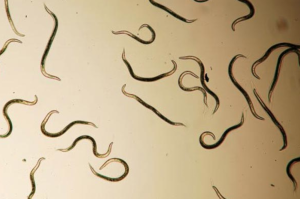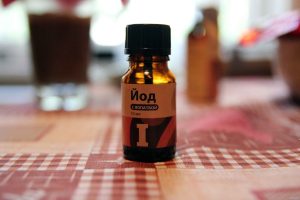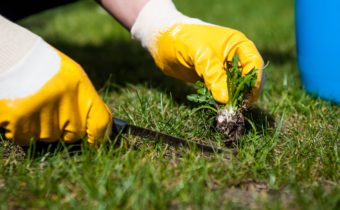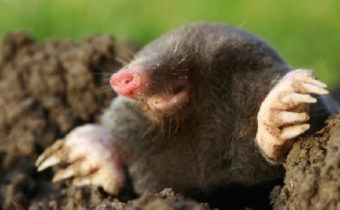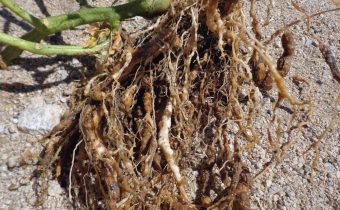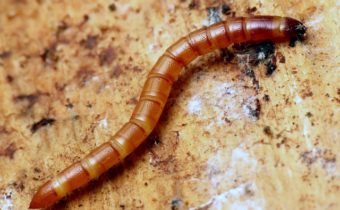Domestic worms, why are they?
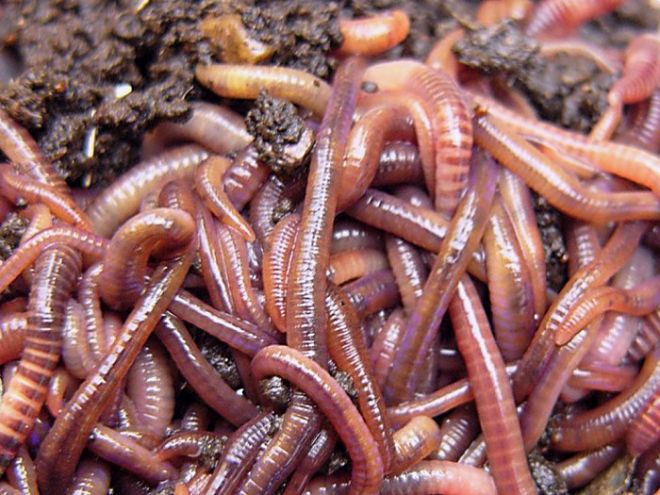
A layer of fertile soil in one cubic centimeter is created in nature for 250-350 years. Innovative technologies with the use of living organisms-worms solve technological problems of creating natural black soil a million times faster.
In suburban areas, the population of primary invertebrates is decreasing every year. Therefore, many gardeners remove them artificially or buy the finished product in specialized stores.
The composition and benefits of the application
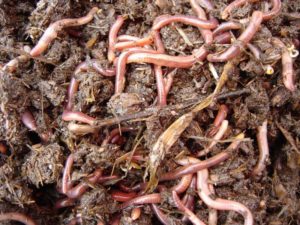 Organic fertilizer, which is a product of processing of annelids, is characterized by the intensity of microbiological processes. With the direct participation of its enzymes, nutrient elements that are difficult to assimilate are transformed into easily digestible elements for any plant.
Organic fertilizer, which is a product of processing of annelids, is characterized by the intensity of microbiological processes. With the direct participation of its enzymes, nutrient elements that are difficult to assimilate are transformed into easily digestible elements for any plant.
Contains the chemical elements necessary for the flow of vital processes in living organisms, phytoestrogens and growth stimulants, which act as active sorbents. In addition, biological humus contains antimicrobial metabolites and a synthesized deterrent substance. Component deter attacks of pathogens and insect pests when growing crops in both open and closed ground. Due to the use of fertilizer produced by special annelids on the plots:
- the safety of the harvest of fruits and vegetables is increased by 1, 5-2 times;
- the content of sucrose, vitamins and carbon in fruits increases by 2.5 times;
- the content of nitric acid salts in fruits and vegetables decreases;
- the inflow of toxic chemicals and harmful radioactive atoms in the soil to the plants is reduced;
- fruit production increases;
- cuttings and cuttings root better, the active formation of their roots is stimulated;
- terms of germination of seeds are reduced;
- foliage of plants becomes saturated green healthy color;
- decreases the incidence of crops;
- the survival rate of plants is increased by 5-6 times;
- money is saved for the purchase of mineral complex fertilizers, fungicides and insecticides.
If you want to make a "wormhole" with your own hands, the cost will be no more than 3,000 rubles.
Biohumus
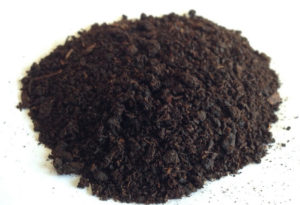 Natural fertilizer, obtained by isolating the enzymes of annelids, has many beneficial properties and is completely harmless. Using properly prepared compost helps to get increased yields, increase the growth of any plant, increase soil fertility. In addition, when making coprolite, the following are restored: degraded and impoverished lands, marshy wetlands, clogged sandy and rocky areas.
Natural fertilizer, obtained by isolating the enzymes of annelids, has many beneficial properties and is completely harmless. Using properly prepared compost helps to get increased yields, increase the growth of any plant, increase soil fertility. In addition, when making coprolite, the following are restored: degraded and impoverished lands, marshy wetlands, clogged sandy and rocky areas.
The formation of a universal feeding occurs in special in-depth structures with the help of decapitation of cow, chicken, goat or rabbit manure. Farm animal excreta are the product of vital activity of primary invertebrates. It can also be produced using an electrical unit that disposes organic waste into biogas. It has a long period of decay, so with sufficient composting into the soil, a decent seasonal harvest can be harvested for more than fifteen years.
Vermichay
A substance that is a coprolite extract with a high content of alkali hydroxides and live beneficial bacteria. It includes a large number:
- the smallest living organisms;
- chemicals produced by microorganisms that inhibit the growth and development of pathogenic bacteria;
- macronutrients necessary for normal plant life;
- Riboflabina, from which plants increase resistance to common diseases;
- niacin involved in the metabolism and vital functions of crops;
- folic acid to help plants improve crop quality;
- vitamin B6, involved in the development of the ability of crops to withstand stress factors;
- thiamine helps plants synthesize carbohydrates. And also to perceive phosphorus, enhancing the growth of flowers and fruit formation;
- auxins, accelerating the process of rooting.
The use of “tea extracts” from enzymes produced by worms will saturate the soil and plants with the necessary deficient nutrients. Its use is safe for nature and human health. Regular treatment with fertilizer will prevent the attack of pathogens, restore soil fertility.
The use of vermica in the cultivation of vegetables reduces the introduction of complex mineral fertilizers and pesticides by 60%.
Ways to get fertilizer
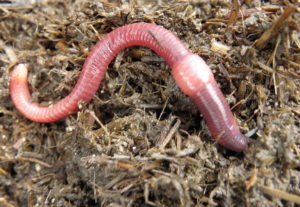 For breeding useful primary invertebrates, you can dig up animals in heaps with manure or garden debris, laying them in special grooves. In this case, you should choose in advance the place where the population will multiply, choose the appropriate food for the worms, think over the wintering of animals. If you don’t want to breed worms in the area, you can purchase biological products made from Vermicompost extract.
For breeding useful primary invertebrates, you can dig up animals in heaps with manure or garden debris, laying them in special grooves. In this case, you should choose in advance the place where the population will multiply, choose the appropriate food for the worms, think over the wintering of animals. If you don’t want to breed worms in the area, you can purchase biological products made from Vermicompost extract.
Purchased drugs
Among the gardeners engaged in ecological farming, liquid biological products obtained from biohumus using extraction by biological or chemical methods are popular.
Water
Environmentally friendly low-cost remedies soil fertility, revitalizing plants with repellent properties against pathogen and parasitic insects. In its composition contain:
- a mixture of high-molecular natural organic compounds, which are the basis of the composition of the soil;
- aggressive fraction of humic substances soluble in water, alkalis and acids;
- organic compounds containing carboxyl and amine groups;
- biologically active substances of the peptide form;
- low molecular weight organic compounds necessary for the normal life of plants;
- hormones;
- chemicals that are actively involved in the biological exchange of energy needed for plant growth;
- living rhizosphere microorganisms;
- mycorrhiza microflora.
Tomatoes are infected with a nematode, what to do?
A dangerous pest of garden crops and tomatoes, including nematodes, capable of destroying more in the shortest possible time ...
Liquid humic
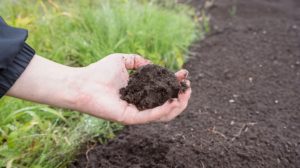 Liquid biopreparations are obtained by ashing at an elevated temperature of the initial substrate. The chemical process allows to obtain more saturated preparations that contain water-soluble and alkali-soluble elements. Due to the oxygen-ash treatment, coprolite is not only extracting all the elements necessary for plant life. After that, the activity of high-molecular-weight organic compounds is enhanced several times, which in the process are converted into water-soluble humic acid salts.
Liquid biopreparations are obtained by ashing at an elevated temperature of the initial substrate. The chemical process allows to obtain more saturated preparations that contain water-soluble and alkali-soluble elements. Due to the oxygen-ash treatment, coprolite is not only extracting all the elements necessary for plant life. After that, the activity of high-molecular-weight organic compounds is enhanced several times, which in the process are converted into water-soluble humic acid salts.
Fertilizers of this type are used for:
- increase root formation;
- active stimulation of growth of planting material;
- improve the survival rate of plants.
By treating with a liquid medium only once at the beginning of the growing season, vegetables or fruit crops, you can increase the yield by 30 percent.
Ballast
Type of biologics, in the manufacture of which high molecular weight organic compounds are not separated from the main substrate. In the form of key coprolite, the initial product formed by coalification of brown and humus type coals is used. These fertilizers: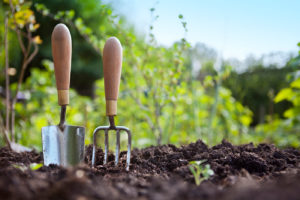
- improve the quality of the soil structure of any type;
- maintain the balance of good microflora, which does not allow pathogens to develop in the soil;
- increase the immunity of young plants to defeat infections and pathogens;
- struggling with harmful microorganisms of fruits and vegetables embedded in storage.
Wormwork DIY
Each gardener can prepare a natural fertilizer, obtained by isolating the enzymes of the ringed worms without difficulty. To do this, prepare in-depth construction of a plastic or wooden box. Organic residues and excrement of farm animals will attract worms. If you wish to obtain better processing of organic residues, purchase primary invertebrates in specialized stores or private worm farms.
Buy queen technical diggers can be in online stores at a price of 900 rubles per family.
Suitable types of worms
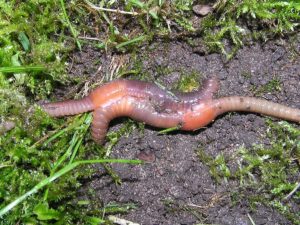 In specialized stores or on private farms, primary invertebrate prospectors are sold in land mix with a supply of food for 7-10 days. Manufacturers of natural humus claim that the best to create coprolite are:
In specialized stores or on private farms, primary invertebrate prospectors are sold in land mix with a supply of food for 7-10 days. Manufacturers of natural humus claim that the best to create coprolite are:
- hybrid "Staratel", derived by Russian scientists. For breeding this hybrid requires warmth, good nutrition and non-chlorinated water. Not demanding of sunlight;
- "Dung" - a productive breed that has the ability to breed in dung heaps without shelter for the winter;
- “Zemlyanoy” is a breed that is rapidly breeding and is massing, processing any organic matter into high-quality coprolite
- "Venetta Dendrobena" is an invertebrate hybrid that can adapt to low temperatures when grown. Its population begins reproduction at a temperature of +10 degrees. Feels good in any type of waste.
Growing conditions
For breeding of the population of primary invertebrates, any waterproof room will be suitable. When raising animals on the street, build special grooves, piles or a box-composter. To determine the composting structure on a site where bright sunshine does not fall, so that excessive moisture can flow out of the habitat of animals unhindered.
For boxes prepare a nutritional mixture, consisting of:
- rotten excrement of farm animals;
- vegetable and kitchen residues;
- river sand;
- small wood chips.
Fresh manure for breeding invertebrates can not be made. And before running animals into it, the substrate must be heated in the sun at an air temperature of 25 degrees for 5-7 days. Or, add quicklime to it at the rate of 2.5 kg of substance per centner of manure. After warming up before starting the worms, the substrate must be checked. To do this, you need to run several animals into it. If the invertebrates have gone deep within half an hour, the substrate can be used. In the event that the animals remained on the surface, the manure is not ready for use.
The size of the growth of propionic acid bacteria in the substrate should have an indicator of not more than 7 PH. If the acidity reaction exceeds the index, invertebrate prospectors will die within a week.
Humidity
To maintain optimum humidity, the surface of the substrate should be sprayed with separated water with a spray gun once every three to four days. Its structure should be similar to the usual washcloth, which is well pressed. Primordial invertebrates like an environment with a humidity of 68% -78%.If its parameters decrease to 40%, the animals will be sick and die. Water the future humus once every four to six days with warm non-chlorinated water.
Temperature
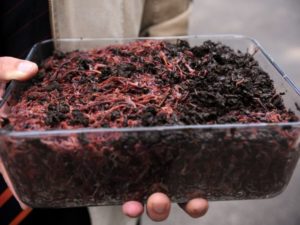 The optimal temperature parameters for the life of invertebrate prospectors are +16 - +30 degrees. A low or high temperature regime will result in the death of animals.
The optimal temperature parameters for the life of invertebrate prospectors are +16 - +30 degrees. A low or high temperature regime will result in the death of animals.
When keeping animals on the street, with the onset of frost, move the composting facilities to a waterproof room, covered with old blankets.
Feeding time
The first feeding of primary invertebrates is carried out a few days after their launch into the substrate. To do this, over the entire surface of the future coprolite a layer of 15 cm spill food or plant residues:
- eggshells;
- crackers;
- peel carrots, beets, potatoes;
- husks of seeds, onions and garlic;
- the remains of fruit;
- hay or straw.
All residues must be crushed, as animals will process larger pieces of waste longer, starting their eating only after complete decomposition. Feeding on kitchen waste, invertebrate miners produce coprolite, which is worse in structure and quality than when fed with rotten excrement of farm animals. The rotted manure is a transformed organic, easily digestible by worms, which will turn it into a quality loose coprolit.
The addition to the substrate of a large number of succulent herbs at an air temperature of over +20 degrees quickly burns out. This process can cause burns to worms, leading to their death.
Getting rid of midges
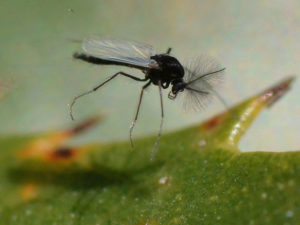 Often penetrate into the substrate black flies or with a gray-yellow color. At the beginning of the appearance of insects are on the surface of the compost, and then go deep into the pupation and reproduction. Their appearance indicates that coprolite contains a large amount of food for invertebrates. To neutralize the insects, contributing to the occurrence of an unpleasant odor, the amount of food for the worms must be reduced, new portions of food sprinkle with dry earth. Cover the substrate with gauze, folded in several layers.
Often penetrate into the substrate black flies or with a gray-yellow color. At the beginning of the appearance of insects are on the surface of the compost, and then go deep into the pupation and reproduction. Their appearance indicates that coprolite contains a large amount of food for invertebrates. To neutralize the insects, contributing to the occurrence of an unpleasant odor, the amount of food for the worms must be reduced, new portions of food sprinkle with dry earth. Cover the substrate with gauze, folded in several layers.
Fertilizer readiness
Fertilizer maturity should be determined by its appearance:
- lack of pieces of pledged organic matter;
- homogeneous mass of rich black color, pleasant to the touch;
- eruption of primary invertebrates.
After complete processing by underground diggers of organic matter, start collecting coprolite. If the vermicomposter will be used immediately after sampling, there is no need to process the product. If you plan to store a worm for some time, it should be dried.
How to feed seedlings with iodine
More recently, it was impossible to find drugs containing iodine in agricultural stores. Today such ...
Terms of collection and storage
The mass of primary invertebrates every two months is doubled. For twelve months, the population of animals weighing 1 kg, increases the mass to one centner. And one individual for twelve months gives rise to more than one thousand worms. One centner of animals passes through itself the same amount of organic matter. At the same time about 50 kg of raw can be removed daily.
Surplus coprolite can be sold to farmers and flower farms or sold by creating your own online agromarket.
Under all conditions for the cultivation of invertebrates, the coprolite is ready in 140-180 days. During this time, the miners multiply by two or three times. Therefore, to continue the process of creating vermicompost, select some of the individuals, leave the other animals. Agrotechnical period of preservation of the selected finished and dried raw materials is unlimited.
The use of vermitechnology is gaining more and more popularity among summer residents and owners of large agricultural land.And the production of primary invertebrates, if desired, can be a promising business. Although the technology is not easy and not cheap, obtaining an environmentally friendly and decent harvest is worth the effort and effort.

